HI3042 Taxation Law T2 2017 Individual Assignment Analysis
VerifiedAdded on 2020/04/07
|11
|2646
|38
Homework Assignment
AI Summary
This assignment solution addresses several key areas of taxation law. Question 1 analyzes the deductibility of various business expenses, differentiating between capital and revenue expenditures, and applying relevant sections of the ITAA 1997. Question 2 focuses on GST credits, examining the eligibility of a bank for input tax credits on advertising campaigns. Question 3 delves into foreign tax offsets, outlining the calculation of Angelo's foreign tax offset based on different income sources and allowable deductions. Question 4 examines partnership taxation, determining taxable income, deductible expenses, and the treatment of partner salaries and other transactions within a partnership structure, including GST. The solution provides detailed explanations and references to relevant legal provisions and case studies.
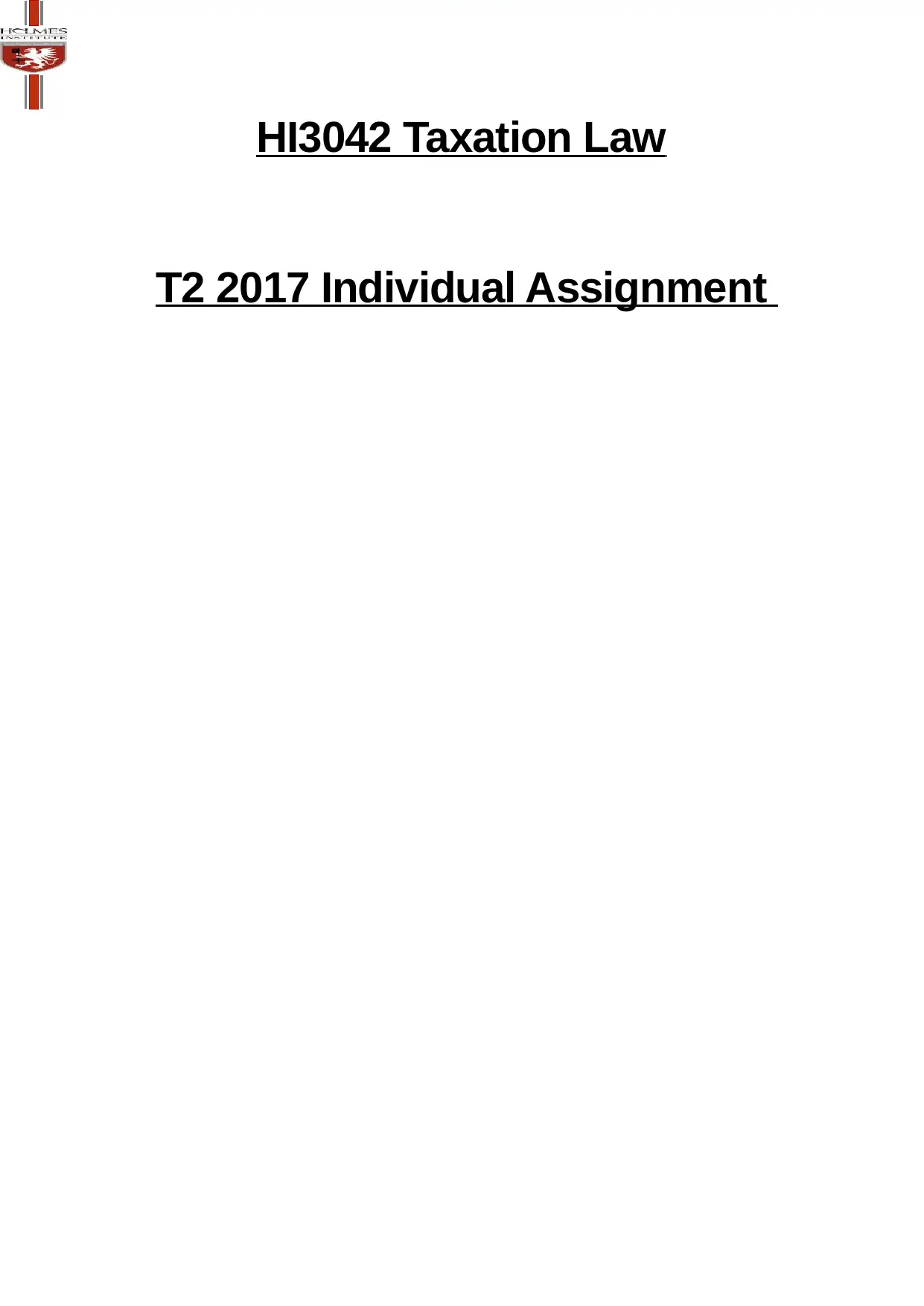
HI3042 Taxation Law
T2 2017 Individual Assignment
T2 2017 Individual Assignment
Paraphrase This Document
Need a fresh take? Get an instant paraphrase of this document with our AI Paraphraser

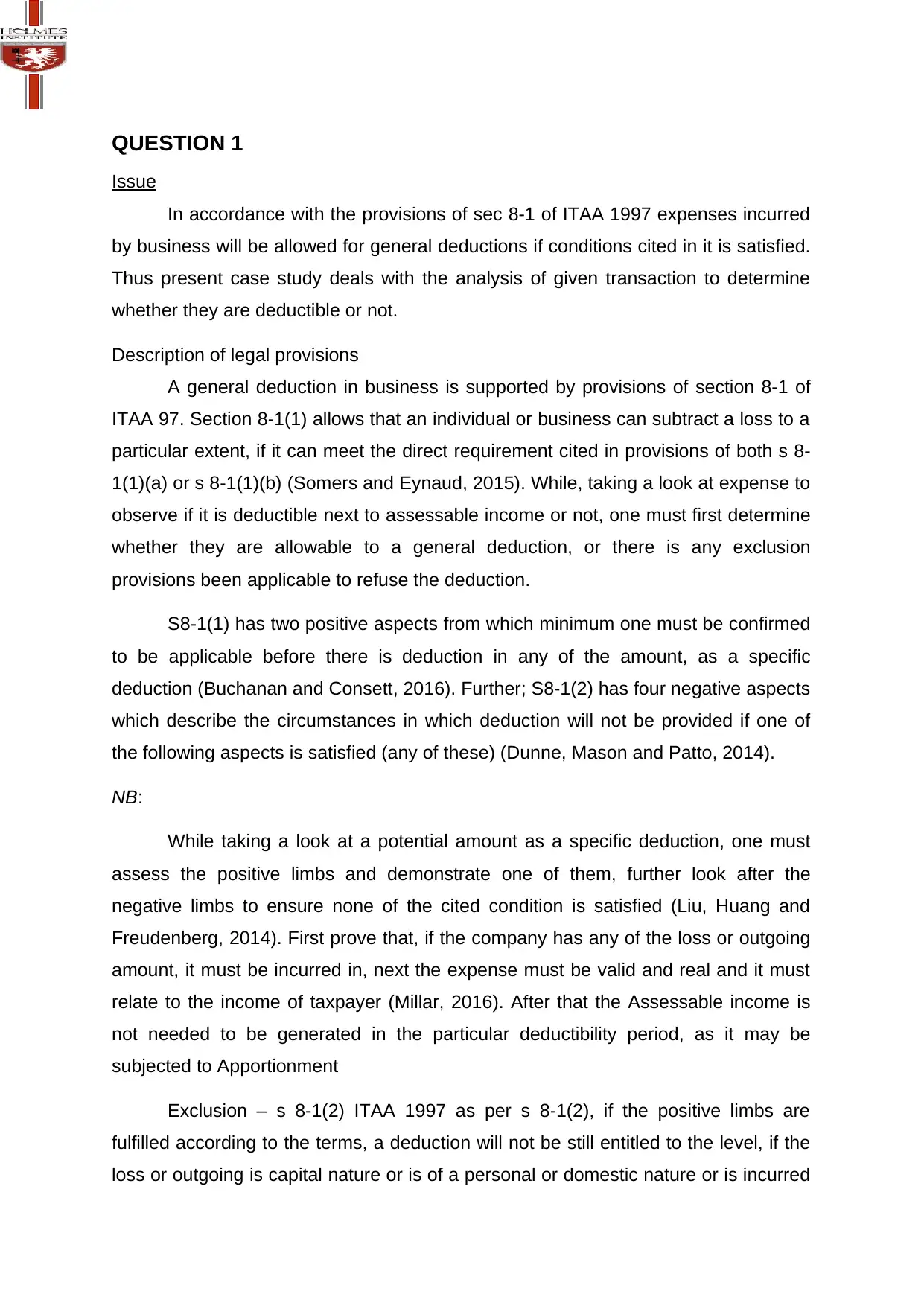
QUESTION 1
Issue
In accordance with the provisions of sec 8-1 of ITAA 1997 expenses incurred
by business will be allowed for general deductions if conditions cited in it is satisfied.
Thus present case study deals with the analysis of given transaction to determine
whether they are deductible or not.
Description of legal provisions
A general deduction in business is supported by provisions of section 8-1 of
ITAA 97. Section 8-1(1) allows that an individual or business can subtract a loss to a
particular extent, if it can meet the direct requirement cited in provisions of both s 8-
1(1)(a) or s 8-1(1)(b) (Somers and Eynaud, 2015). While, taking a look at expense to
observe if it is deductible next to assessable income or not, one must first determine
whether they are allowable to a general deduction, or there is any exclusion
provisions been applicable to refuse the deduction.
S8-1(1) has two positive aspects from which minimum one must be confirmed
to be applicable before there is deduction in any of the amount, as a specific
deduction (Buchanan and Consett, 2016). Further; S8-1(2) has four negative aspects
which describe the circumstances in which deduction will not be provided if one of
the following aspects is satisfied (any of these) (Dunne, Mason and Patto, 2014).
NB:
While taking a look at a potential amount as a specific deduction, one must
assess the positive limbs and demonstrate one of them, further look after the
negative limbs to ensure none of the cited condition is satisfied (Liu, Huang and
Freudenberg, 2014). First prove that, if the company has any of the loss or outgoing
amount, it must be incurred in, next the expense must be valid and real and it must
relate to the income of taxpayer (Millar, 2016). After that the Assessable income is
not needed to be generated in the particular deductibility period, as it may be
subjected to Apportionment
Exclusion – s 8-1(2) ITAA 1997 as per s 8-1(2), if the positive limbs are
fulfilled according to the terms, a deduction will not be still entitled to the level, if the
loss or outgoing is capital nature or is of a personal or domestic nature or is incurred
Issue
In accordance with the provisions of sec 8-1 of ITAA 1997 expenses incurred
by business will be allowed for general deductions if conditions cited in it is satisfied.
Thus present case study deals with the analysis of given transaction to determine
whether they are deductible or not.
Description of legal provisions
A general deduction in business is supported by provisions of section 8-1 of
ITAA 97. Section 8-1(1) allows that an individual or business can subtract a loss to a
particular extent, if it can meet the direct requirement cited in provisions of both s 8-
1(1)(a) or s 8-1(1)(b) (Somers and Eynaud, 2015). While, taking a look at expense to
observe if it is deductible next to assessable income or not, one must first determine
whether they are allowable to a general deduction, or there is any exclusion
provisions been applicable to refuse the deduction.
S8-1(1) has two positive aspects from which minimum one must be confirmed
to be applicable before there is deduction in any of the amount, as a specific
deduction (Buchanan and Consett, 2016). Further; S8-1(2) has four negative aspects
which describe the circumstances in which deduction will not be provided if one of
the following aspects is satisfied (any of these) (Dunne, Mason and Patto, 2014).
NB:
While taking a look at a potential amount as a specific deduction, one must
assess the positive limbs and demonstrate one of them, further look after the
negative limbs to ensure none of the cited condition is satisfied (Liu, Huang and
Freudenberg, 2014). First prove that, if the company has any of the loss or outgoing
amount, it must be incurred in, next the expense must be valid and real and it must
relate to the income of taxpayer (Millar, 2016). After that the Assessable income is
not needed to be generated in the particular deductibility period, as it may be
subjected to Apportionment
Exclusion – s 8-1(2) ITAA 1997 as per s 8-1(2), if the positive limbs are
fulfilled according to the terms, a deduction will not be still entitled to the level, if the
loss or outgoing is capital nature or is of a personal or domestic nature or is incurred
⊘ This is a preview!⊘
Do you want full access?
Subscribe today to unlock all pages.

Trusted by 1+ million students worldwide
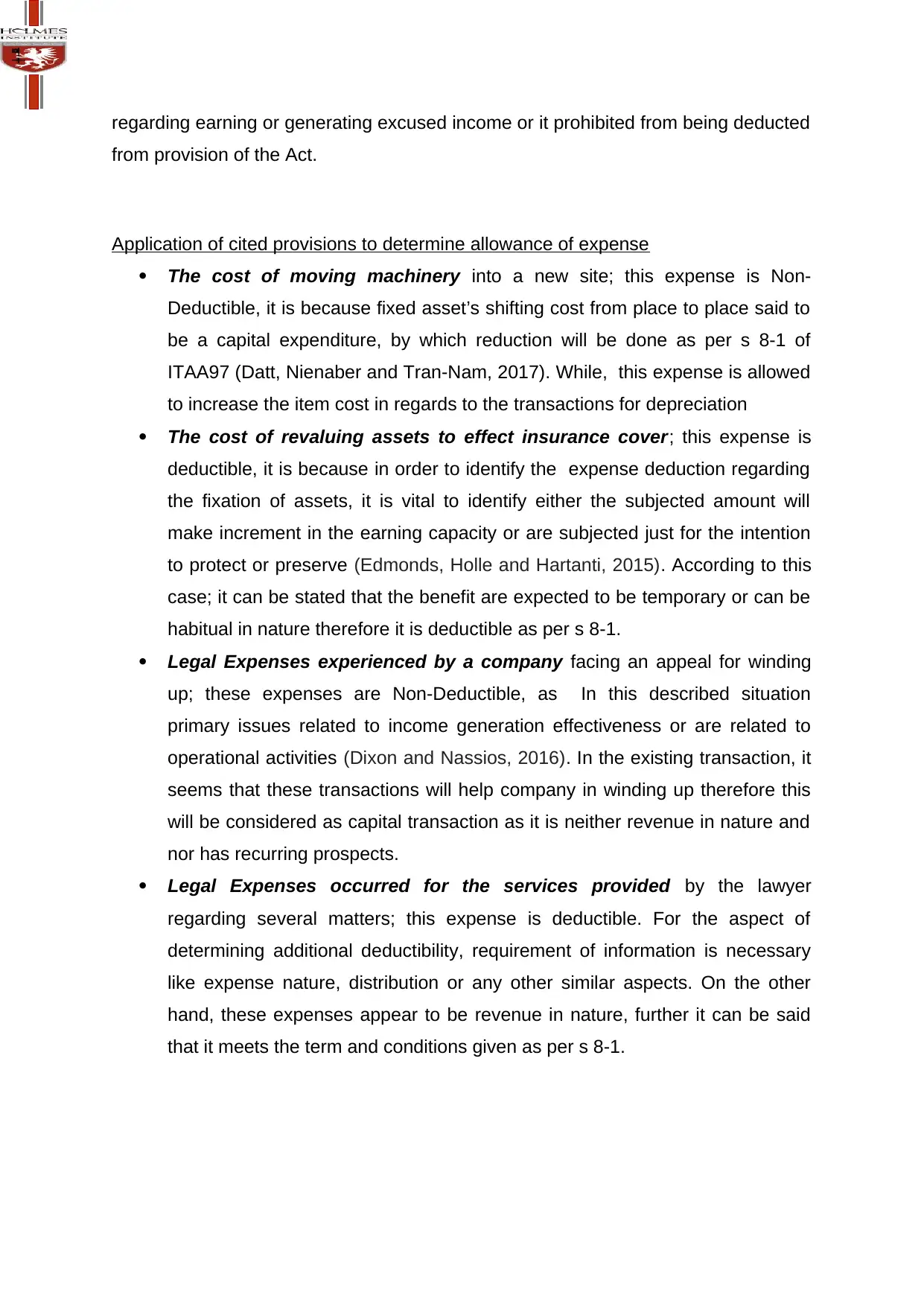
regarding earning or generating excused income or it prohibited from being deducted
from provision of the Act.
Application of cited provisions to determine allowance of expense
The cost of moving machinery into a new site; this expense is Non-
Deductible, it is because fixed asset’s shifting cost from place to place said to
be a capital expenditure, by which reduction will be done as per s 8-1 of
ITAA97 (Datt, Nienaber and Tran-Nam, 2017). While, this expense is allowed
to increase the item cost in regards to the transactions for depreciation
The cost of revaluing assets to effect insurance cover; this expense is
deductible, it is because in order to identify the expense deduction regarding
the fixation of assets, it is vital to identify either the subjected amount will
make increment in the earning capacity or are subjected just for the intention
to protect or preserve (Edmonds, Holle and Hartanti, 2015). According to this
case; it can be stated that the benefit are expected to be temporary or can be
habitual in nature therefore it is deductible as per s 8-1.
Legal Expenses experienced by a company facing an appeal for winding
up; these expenses are Non-Deductible, as In this described situation
primary issues related to income generation effectiveness or are related to
operational activities (Dixon and Nassios, 2016). In the existing transaction, it
seems that these transactions will help company in winding up therefore this
will be considered as capital transaction as it is neither revenue in nature and
nor has recurring prospects.
Legal Expenses occurred for the services provided by the lawyer
regarding several matters; this expense is deductible. For the aspect of
determining additional deductibility, requirement of information is necessary
like expense nature, distribution or any other similar aspects. On the other
hand, these expenses appear to be revenue in nature, further it can be said
that it meets the term and conditions given as per s 8-1.
from provision of the Act.
Application of cited provisions to determine allowance of expense
The cost of moving machinery into a new site; this expense is Non-
Deductible, it is because fixed asset’s shifting cost from place to place said to
be a capital expenditure, by which reduction will be done as per s 8-1 of
ITAA97 (Datt, Nienaber and Tran-Nam, 2017). While, this expense is allowed
to increase the item cost in regards to the transactions for depreciation
The cost of revaluing assets to effect insurance cover; this expense is
deductible, it is because in order to identify the expense deduction regarding
the fixation of assets, it is vital to identify either the subjected amount will
make increment in the earning capacity or are subjected just for the intention
to protect or preserve (Edmonds, Holle and Hartanti, 2015). According to this
case; it can be stated that the benefit are expected to be temporary or can be
habitual in nature therefore it is deductible as per s 8-1.
Legal Expenses experienced by a company facing an appeal for winding
up; these expenses are Non-Deductible, as In this described situation
primary issues related to income generation effectiveness or are related to
operational activities (Dixon and Nassios, 2016). In the existing transaction, it
seems that these transactions will help company in winding up therefore this
will be considered as capital transaction as it is neither revenue in nature and
nor has recurring prospects.
Legal Expenses occurred for the services provided by the lawyer
regarding several matters; this expense is deductible. For the aspect of
determining additional deductibility, requirement of information is necessary
like expense nature, distribution or any other similar aspects. On the other
hand, these expenses appear to be revenue in nature, further it can be said
that it meets the term and conditions given as per s 8-1.
Paraphrase This Document
Need a fresh take? Get an instant paraphrase of this document with our AI Paraphraser
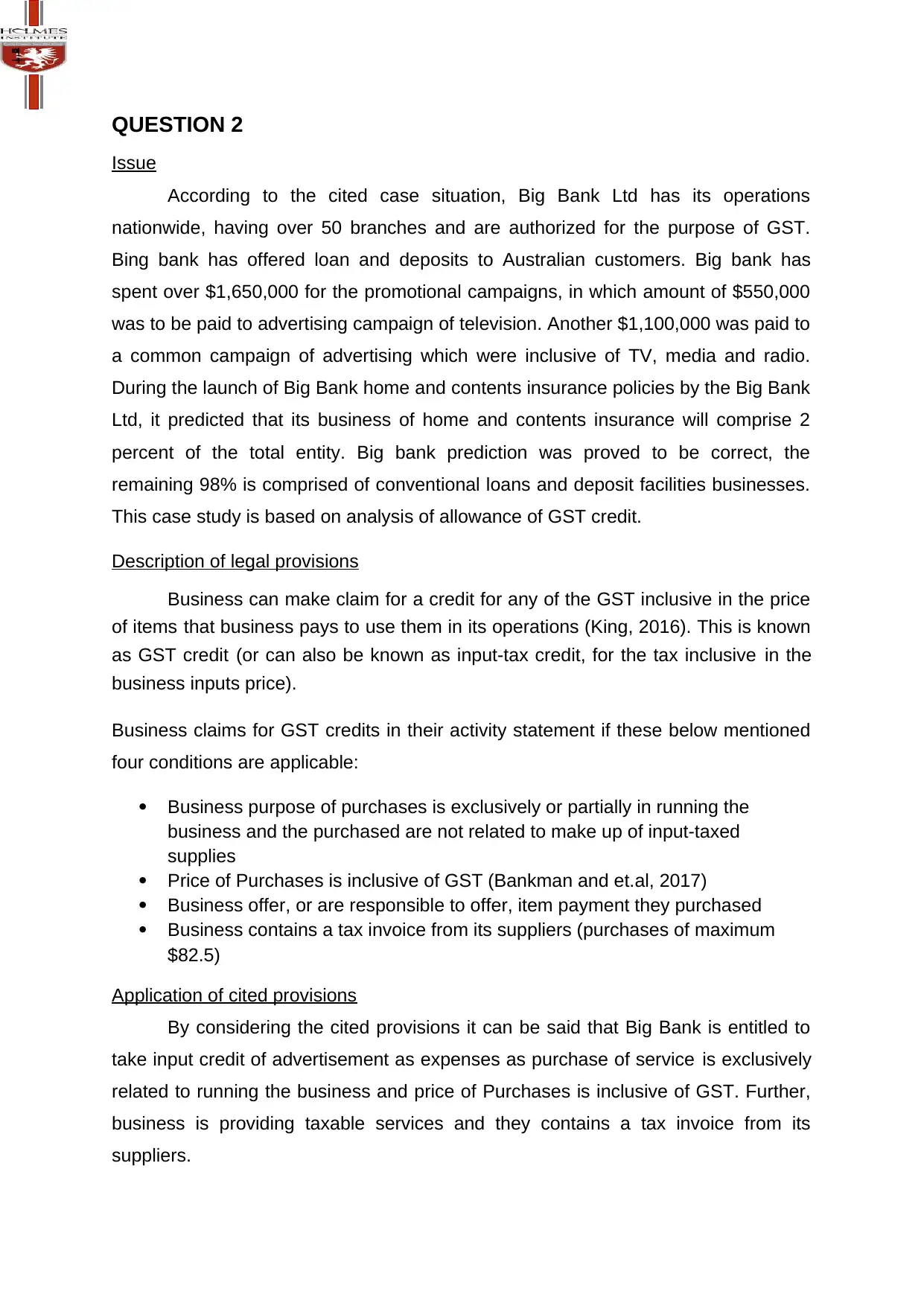
QUESTION 2
Issue
According to the cited case situation, Big Bank Ltd has its operations
nationwide, having over 50 branches and are authorized for the purpose of GST.
Bing bank has offered loan and deposits to Australian customers. Big bank has
spent over $1,650,000 for the promotional campaigns, in which amount of $550,000
was to be paid to advertising campaign of television. Another $1,100,000 was paid to
a common campaign of advertising which were inclusive of TV, media and radio.
During the launch of Big Bank home and contents insurance policies by the Big Bank
Ltd, it predicted that its business of home and contents insurance will comprise 2
percent of the total entity. Big bank prediction was proved to be correct, the
remaining 98% is comprised of conventional loans and deposit facilities businesses.
This case study is based on analysis of allowance of GST credit.
Description of legal provisions
Business can make claim for a credit for any of the GST inclusive in the price
of items that business pays to use them in its operations (King, 2016). This is known
as GST credit (or can also be known as input-tax credit, for the tax inclusive in the
business inputs price).
Business claims for GST credits in their activity statement if these below mentioned
four conditions are applicable:
Business purpose of purchases is exclusively or partially in running the
business and the purchased are not related to make up of input-taxed
supplies
Price of Purchases is inclusive of GST (Bankman and et.al, 2017)
Business offer, or are responsible to offer, item payment they purchased
Business contains a tax invoice from its suppliers (purchases of maximum
$82.5)
Application of cited provisions
By considering the cited provisions it can be said that Big Bank is entitled to
take input credit of advertisement as expenses as purchase of service is exclusively
related to running the business and price of Purchases is inclusive of GST. Further,
business is providing taxable services and they contains a tax invoice from its
suppliers.
Issue
According to the cited case situation, Big Bank Ltd has its operations
nationwide, having over 50 branches and are authorized for the purpose of GST.
Bing bank has offered loan and deposits to Australian customers. Big bank has
spent over $1,650,000 for the promotional campaigns, in which amount of $550,000
was to be paid to advertising campaign of television. Another $1,100,000 was paid to
a common campaign of advertising which were inclusive of TV, media and radio.
During the launch of Big Bank home and contents insurance policies by the Big Bank
Ltd, it predicted that its business of home and contents insurance will comprise 2
percent of the total entity. Big bank prediction was proved to be correct, the
remaining 98% is comprised of conventional loans and deposit facilities businesses.
This case study is based on analysis of allowance of GST credit.
Description of legal provisions
Business can make claim for a credit for any of the GST inclusive in the price
of items that business pays to use them in its operations (King, 2016). This is known
as GST credit (or can also be known as input-tax credit, for the tax inclusive in the
business inputs price).
Business claims for GST credits in their activity statement if these below mentioned
four conditions are applicable:
Business purpose of purchases is exclusively or partially in running the
business and the purchased are not related to make up of input-taxed
supplies
Price of Purchases is inclusive of GST (Bankman and et.al, 2017)
Business offer, or are responsible to offer, item payment they purchased
Business contains a tax invoice from its suppliers (purchases of maximum
$82.5)
Application of cited provisions
By considering the cited provisions it can be said that Big Bank is entitled to
take input credit of advertisement as expenses as purchase of service is exclusively
related to running the business and price of Purchases is inclusive of GST. Further,
business is providing taxable services and they contains a tax invoice from its
suppliers.
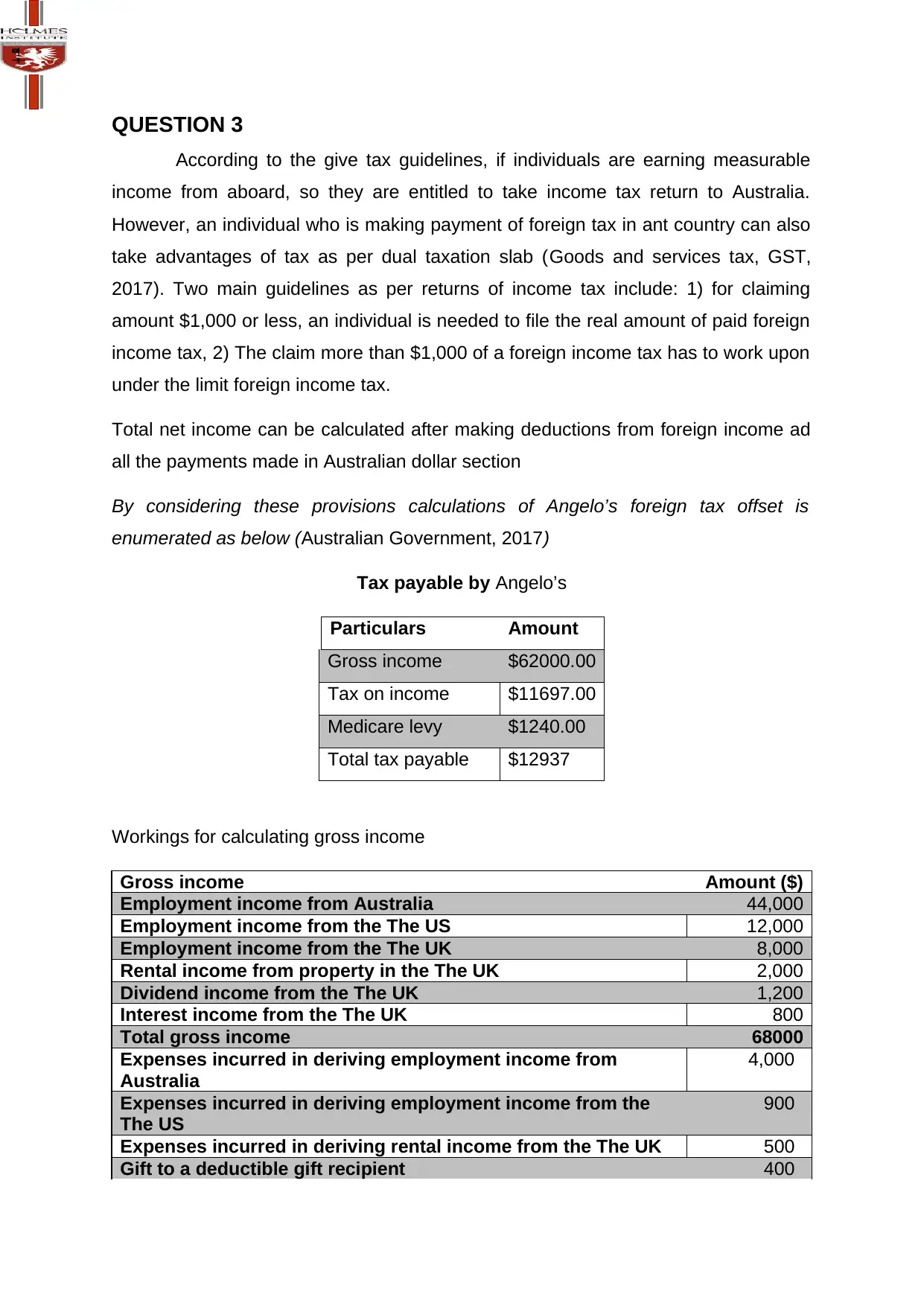
QUESTION 3
According to the give tax guidelines, if individuals are earning measurable
income from aboard, so they are entitled to take income tax return to Australia.
However, an individual who is making payment of foreign tax in ant country can also
take advantages of tax as per dual taxation slab (Goods and services tax, GST,
2017). Two main guidelines as per returns of income tax include: 1) for claiming
amount $1,000 or less, an individual is needed to file the real amount of paid foreign
income tax, 2) The claim more than $1,000 of a foreign income tax has to work upon
under the limit foreign income tax.
Total net income can be calculated after making deductions from foreign income ad
all the payments made in Australian dollar section
By considering these provisions calculations of Angelo’s foreign tax offset is
enumerated as below (Australian Government, 2017)
Tax payable by Angelo’s
Particulars Amount
Gross income $62000.00
Tax on income $11697.00
Medicare levy $1240.00
Total tax payable $12937
Workings for calculating gross income
Gross income Amount ($)
Employment income from Australia 44,000
Employment income from the The US 12,000
Employment income from the The UK 8,000
Rental income from property in the The UK 2,000
Dividend income from the The UK 1,200
Interest income from the The UK 800
Total gross income 68000
Expenses incurred in deriving employment income from
Australia
4,000
Expenses incurred in deriving employment income from the
The US
900
Expenses incurred in deriving rental income from the The UK 500
Gift to a deductible gift recipient 400
According to the give tax guidelines, if individuals are earning measurable
income from aboard, so they are entitled to take income tax return to Australia.
However, an individual who is making payment of foreign tax in ant country can also
take advantages of tax as per dual taxation slab (Goods and services tax, GST,
2017). Two main guidelines as per returns of income tax include: 1) for claiming
amount $1,000 or less, an individual is needed to file the real amount of paid foreign
income tax, 2) The claim more than $1,000 of a foreign income tax has to work upon
under the limit foreign income tax.
Total net income can be calculated after making deductions from foreign income ad
all the payments made in Australian dollar section
By considering these provisions calculations of Angelo’s foreign tax offset is
enumerated as below (Australian Government, 2017)
Tax payable by Angelo’s
Particulars Amount
Gross income $62000.00
Tax on income $11697.00
Medicare levy $1240.00
Total tax payable $12937
Workings for calculating gross income
Gross income Amount ($)
Employment income from Australia 44,000
Employment income from the The US 12,000
Employment income from the The UK 8,000
Rental income from property in the The UK 2,000
Dividend income from the The UK 1,200
Interest income from the The UK 800
Total gross income 68000
Expenses incurred in deriving employment income from
Australia
4,000
Expenses incurred in deriving employment income from the
The US
900
Expenses incurred in deriving rental income from the The UK 500
Gift to a deductible gift recipient 400
⊘ This is a preview!⊘
Do you want full access?
Subscribe today to unlock all pages.

Trusted by 1+ million students worldwide
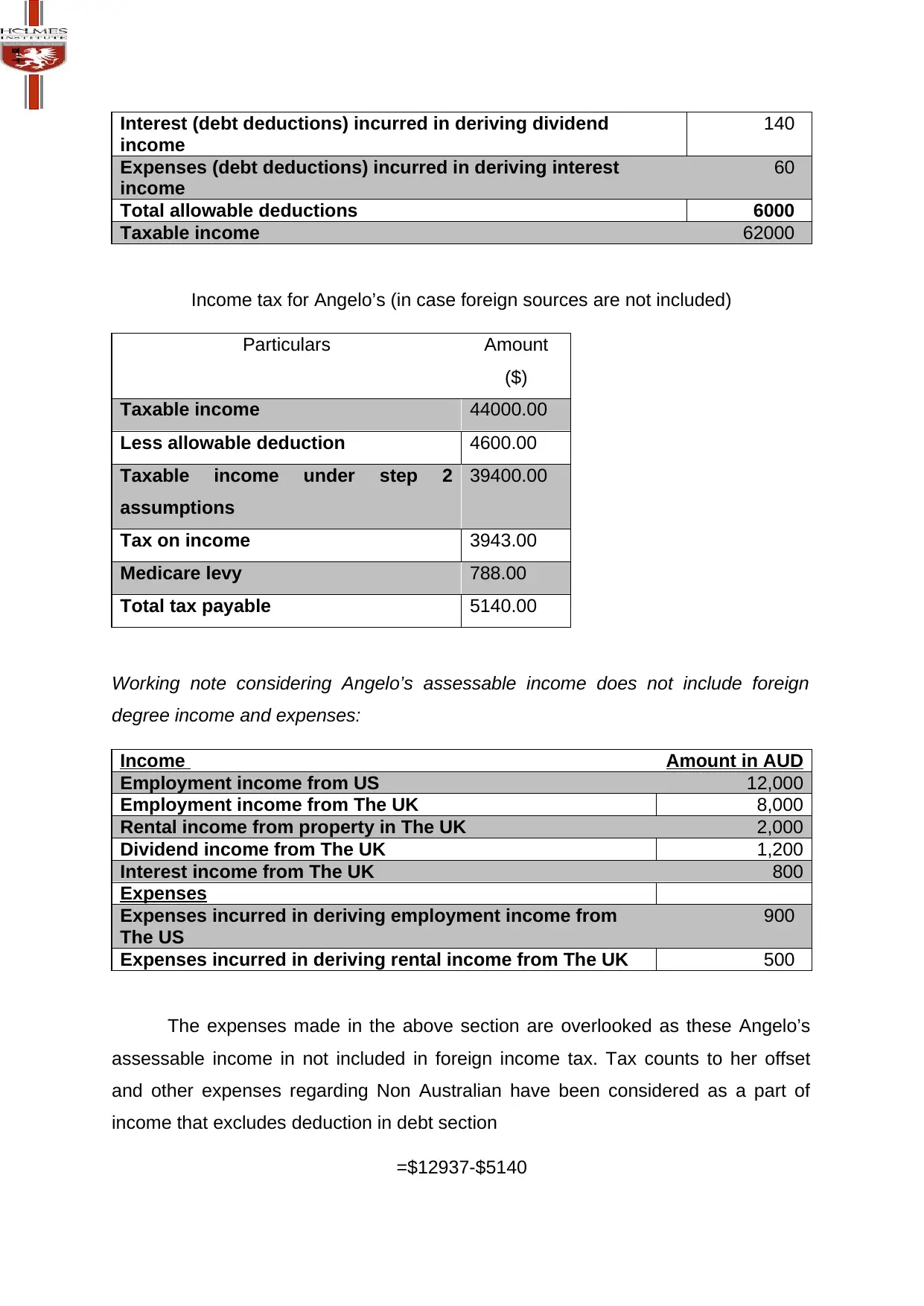
Interest (debt deductions) incurred in deriving dividend
income
140
Expenses (debt deductions) incurred in deriving interest
income
60
Total allowable deductions 6000
Taxable income 62000
Income tax for Angelo’s (in case foreign sources are not included)
Particulars Amount
($)
Taxable income 44000.00
Less allowable deduction 4600.00
Taxable income under step 2
assumptions
39400.00
Tax on income 3943.00
Medicare levy 788.00
Total tax payable 5140.00
Working note considering Angelo’s assessable income does not include foreign
degree income and expenses:
Income Amount in AUD
Employment income from US 12,000
Employment income from The UK 8,000
Rental income from property in The UK 2,000
Dividend income from The UK 1,200
Interest income from The UK 800
Expenses
Expenses incurred in deriving employment income from
The US
900
Expenses incurred in deriving rental income from The UK 500
The expenses made in the above section are overlooked as these Angelo’s
assessable income in not included in foreign income tax. Tax counts to her offset
and other expenses regarding Non Australian have been considered as a part of
income that excludes deduction in debt section
=$12937-$5140
income
140
Expenses (debt deductions) incurred in deriving interest
income
60
Total allowable deductions 6000
Taxable income 62000
Income tax for Angelo’s (in case foreign sources are not included)
Particulars Amount
($)
Taxable income 44000.00
Less allowable deduction 4600.00
Taxable income under step 2
assumptions
39400.00
Tax on income 3943.00
Medicare levy 788.00
Total tax payable 5140.00
Working note considering Angelo’s assessable income does not include foreign
degree income and expenses:
Income Amount in AUD
Employment income from US 12,000
Employment income from The UK 8,000
Rental income from property in The UK 2,000
Dividend income from The UK 1,200
Interest income from The UK 800
Expenses
Expenses incurred in deriving employment income from
The US
900
Expenses incurred in deriving rental income from The UK 500
The expenses made in the above section are overlooked as these Angelo’s
assessable income in not included in foreign income tax. Tax counts to her offset
and other expenses regarding Non Australian have been considered as a part of
income that excludes deduction in debt section
=$12937-$5140
Paraphrase This Document
Need a fresh take? Get an instant paraphrase of this document with our AI Paraphraser
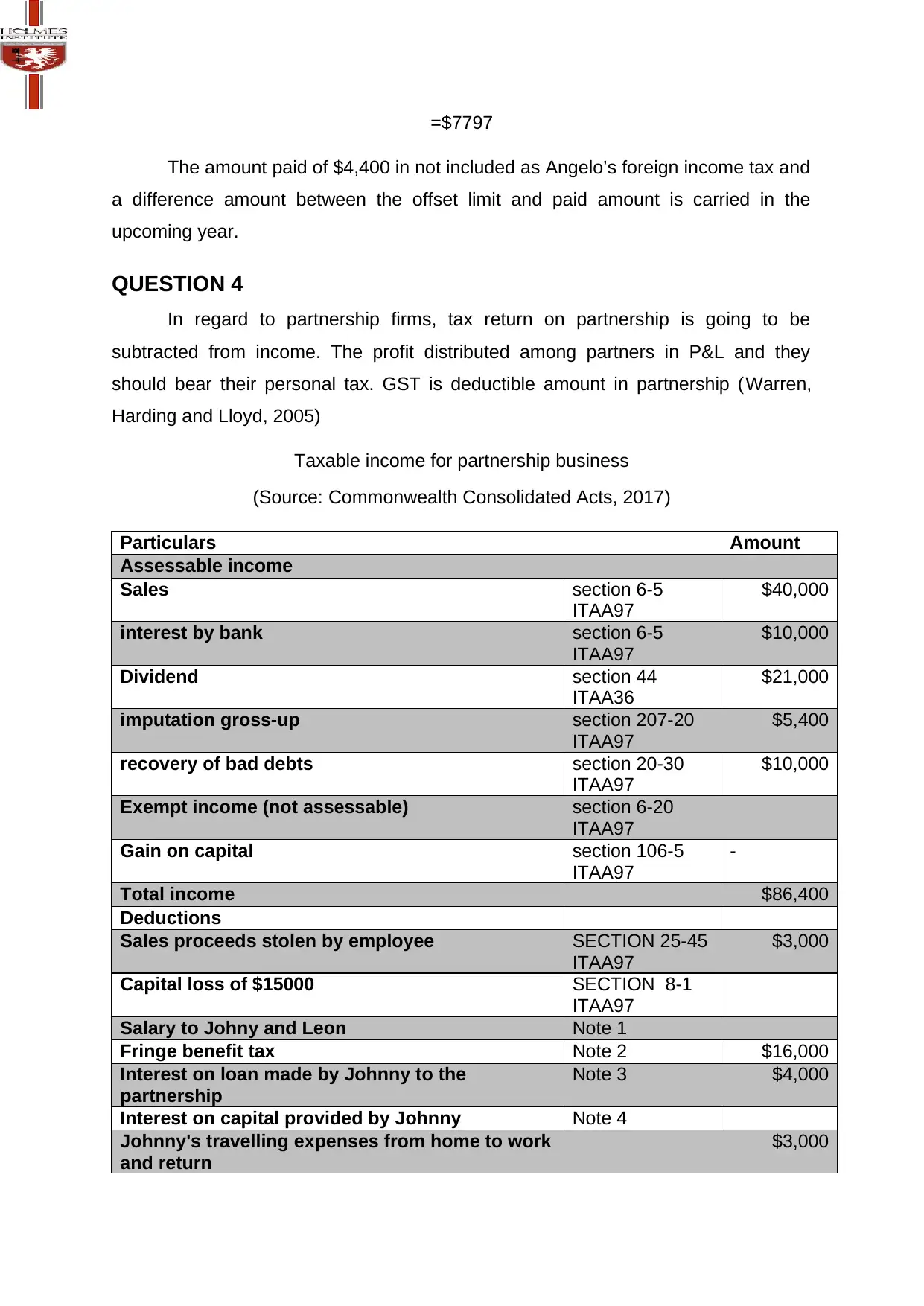
=$7797
The amount paid of $4,400 in not included as Angelo’s foreign income tax and
a difference amount between the offset limit and paid amount is carried in the
upcoming year.
QUESTION 4
In regard to partnership firms, tax return on partnership is going to be
subtracted from income. The profit distributed among partners in P&L and they
should bear their personal tax. GST is deductible amount in partnership (Warren,
Harding and Lloyd, 2005)
Taxable income for partnership business
(Source: Commonwealth Consolidated Acts, 2017)
Particulars Amount
Assessable income
Sales section 6-5
ITAA97
$40,000
interest by bank section 6-5
ITAA97
$10,000
Dividend section 44
ITAA36
$21,000
imputation gross-up section 207-20
ITAA97
$5,400
recovery of bad debts section 20-30
ITAA97
$10,000
Exempt income (not assessable) section 6-20
ITAA97
Gain on capital section 106-5
ITAA97
-
Total income $86,400
Deductions
Sales proceeds stolen by employee SECTION 25-45
ITAA97
$3,000
Capital loss of $15000 SECTION 8-1
ITAA97
Salary to Johny and Leon Note 1
Fringe benefit tax Note 2 $16,000
Interest on loan made by Johnny to the
partnership
Note 3 $4,000
Interest on capital provided by Johnny Note 4
Johnny's travelling expenses from home to work
and return
$3,000
The amount paid of $4,400 in not included as Angelo’s foreign income tax and
a difference amount between the offset limit and paid amount is carried in the
upcoming year.
QUESTION 4
In regard to partnership firms, tax return on partnership is going to be
subtracted from income. The profit distributed among partners in P&L and they
should bear their personal tax. GST is deductible amount in partnership (Warren,
Harding and Lloyd, 2005)
Taxable income for partnership business
(Source: Commonwealth Consolidated Acts, 2017)
Particulars Amount
Assessable income
Sales section 6-5
ITAA97
$40,000
interest by bank section 6-5
ITAA97
$10,000
Dividend section 44
ITAA36
$21,000
imputation gross-up section 207-20
ITAA97
$5,400
recovery of bad debts section 20-30
ITAA97
$10,000
Exempt income (not assessable) section 6-20
ITAA97
Gain on capital section 106-5
ITAA97
-
Total income $86,400
Deductions
Sales proceeds stolen by employee SECTION 25-45
ITAA97
$3,000
Capital loss of $15000 SECTION 8-1
ITAA97
Salary to Johny and Leon Note 1
Fringe benefit tax Note 2 $16,000
Interest on loan made by Johnny to the
partnership
Note 3 $4,000
Interest on capital provided by Johnny Note 4
Johnny's travelling expenses from home to work
and return
$3,000
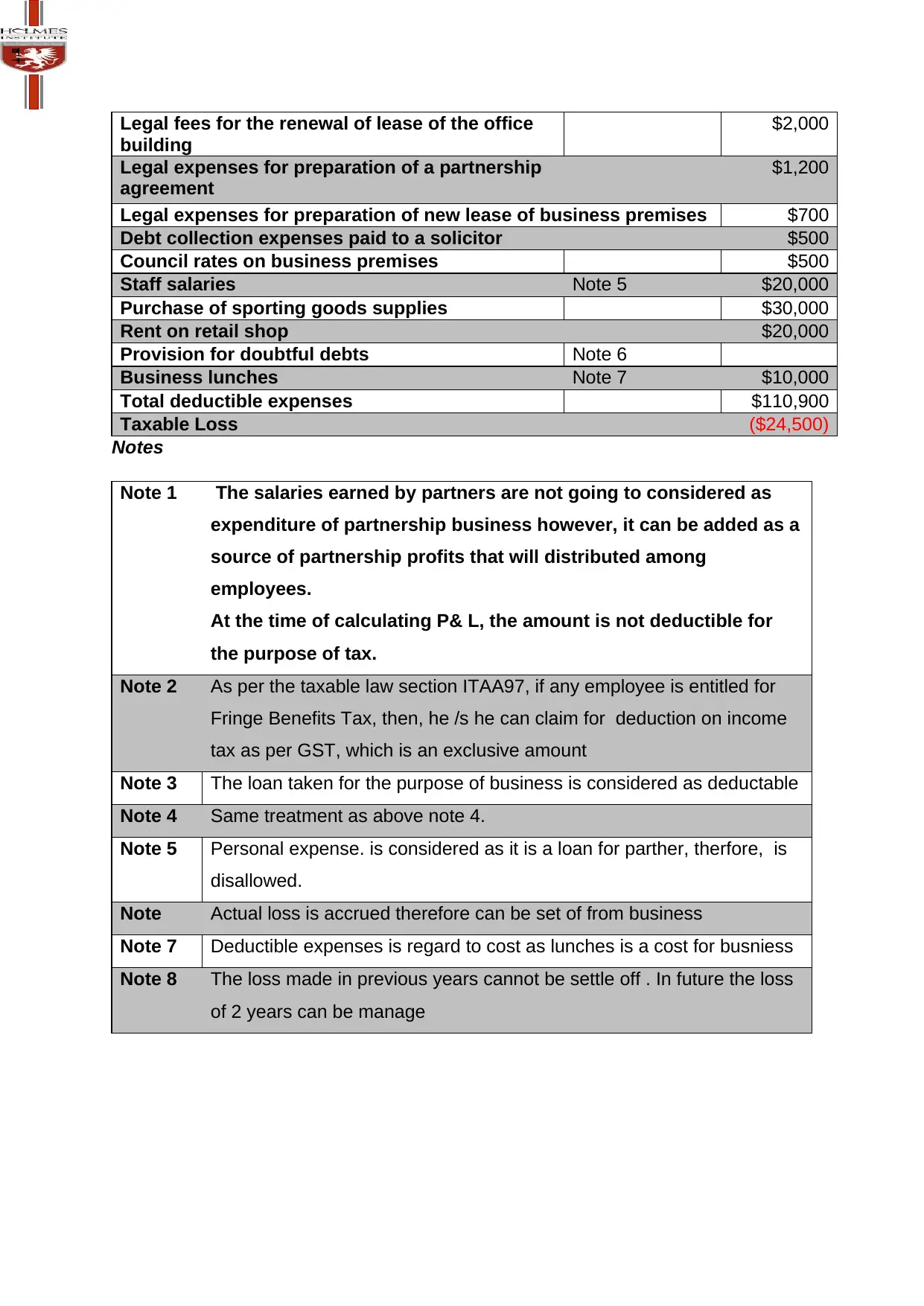
Legal fees for the renewal of lease of the office
building
$2,000
Legal expenses for preparation of a partnership
agreement
$1,200
Legal expenses for preparation of new lease of business premises $700
Debt collection expenses paid to a solicitor $500
Council rates on business premises $500
Staff salaries Note 5 $20,000
Purchase of sporting goods supplies $30,000
Rent on retail shop $20,000
Provision for doubtful debts Note 6
Business lunches Note 7 $10,000
Total deductible expenses $110,900
Taxable Loss ($24,500)
Notes
Note 1 The salaries earned by partners are not going to considered as
expenditure of partnership business however, it can be added as a
source of partnership profits that will distributed among
employees.
At the time of calculating P& L, the amount is not deductible for
the purpose of tax.
Note 2 As per the taxable law section ITAA97, if any employee is entitled for
Fringe Benefits Tax, then, he /s he can claim for deduction on income
tax as per GST, which is an exclusive amount
Note 3 The loan taken for the purpose of business is considered as deductable
Note 4 Same treatment as above note 4.
Note 5 Personal expense. is considered as it is a loan for parther, therfore, is
disallowed.
Note Actual loss is accrued therefore can be set of from business
Note 7 Deductible expenses is regard to cost as lunches is a cost for busniess
Note 8 The loss made in previous years cannot be settle off . In future the loss
of 2 years can be manage
building
$2,000
Legal expenses for preparation of a partnership
agreement
$1,200
Legal expenses for preparation of new lease of business premises $700
Debt collection expenses paid to a solicitor $500
Council rates on business premises $500
Staff salaries Note 5 $20,000
Purchase of sporting goods supplies $30,000
Rent on retail shop $20,000
Provision for doubtful debts Note 6
Business lunches Note 7 $10,000
Total deductible expenses $110,900
Taxable Loss ($24,500)
Notes
Note 1 The salaries earned by partners are not going to considered as
expenditure of partnership business however, it can be added as a
source of partnership profits that will distributed among
employees.
At the time of calculating P& L, the amount is not deductible for
the purpose of tax.
Note 2 As per the taxable law section ITAA97, if any employee is entitled for
Fringe Benefits Tax, then, he /s he can claim for deduction on income
tax as per GST, which is an exclusive amount
Note 3 The loan taken for the purpose of business is considered as deductable
Note 4 Same treatment as above note 4.
Note 5 Personal expense. is considered as it is a loan for parther, therfore, is
disallowed.
Note Actual loss is accrued therefore can be set of from business
Note 7 Deductible expenses is regard to cost as lunches is a cost for busniess
Note 8 The loss made in previous years cannot be settle off . In future the loss
of 2 years can be manage
⊘ This is a preview!⊘
Do you want full access?
Subscribe today to unlock all pages.

Trusted by 1+ million students worldwide
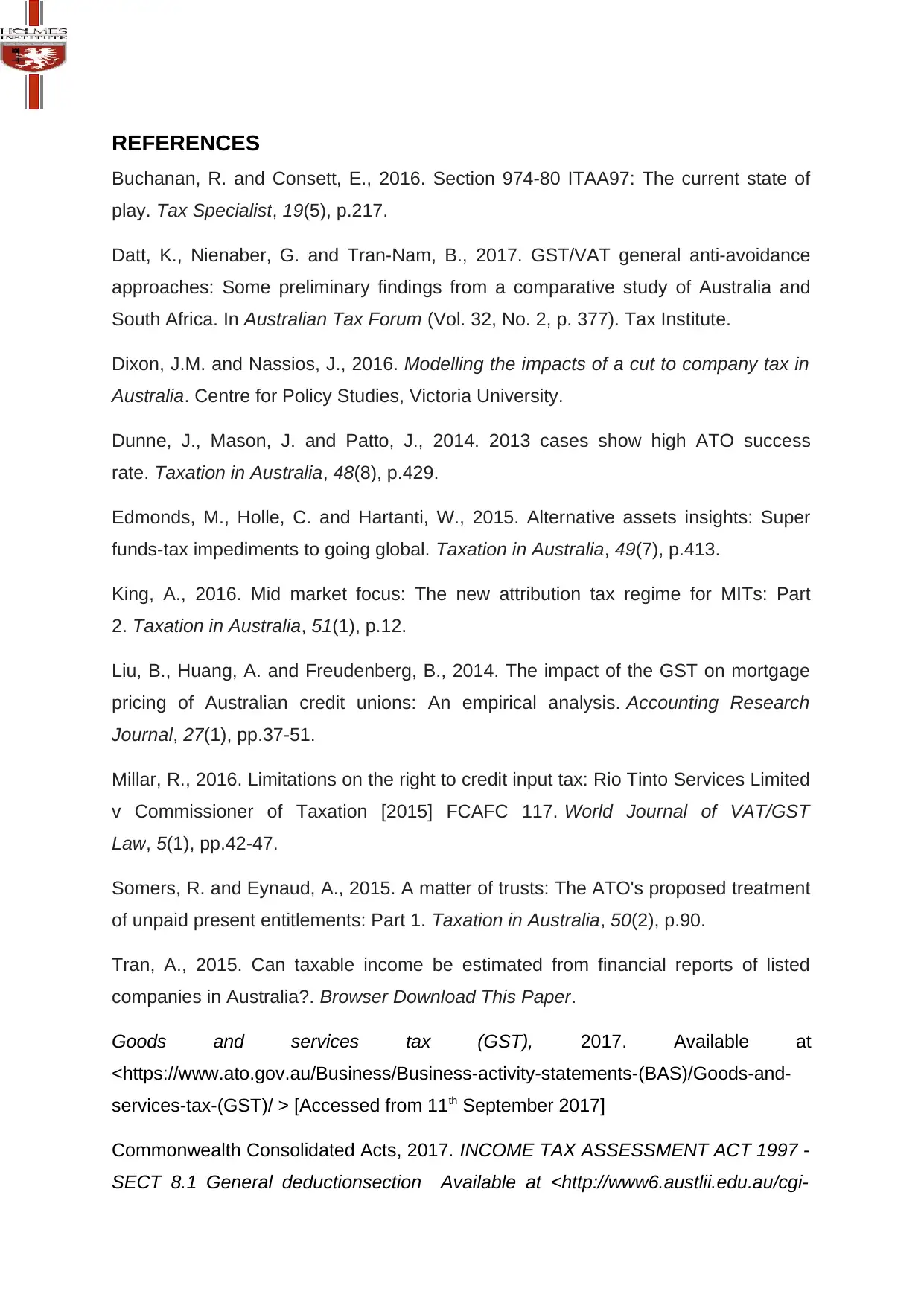
REFERENCES
Buchanan, R. and Consett, E., 2016. Section 974-80 ITAA97: The current state of
play. Tax Specialist, 19(5), p.217.
Datt, K., Nienaber, G. and Tran-Nam, B., 2017. GST/VAT general anti-avoidance
approaches: Some preliminary findings from a comparative study of Australia and
South Africa. In Australian Tax Forum (Vol. 32, No. 2, p. 377). Tax Institute.
Dixon, J.M. and Nassios, J., 2016. Modelling the impacts of a cut to company tax in
Australia. Centre for Policy Studies, Victoria University.
Dunne, J., Mason, J. and Patto, J., 2014. 2013 cases show high ATO success
rate. Taxation in Australia, 48(8), p.429.
Edmonds, M., Holle, C. and Hartanti, W., 2015. Alternative assets insights: Super
funds-tax impediments to going global. Taxation in Australia, 49(7), p.413.
King, A., 2016. Mid market focus: The new attribution tax regime for MITs: Part
2. Taxation in Australia, 51(1), p.12.
Liu, B., Huang, A. and Freudenberg, B., 2014. The impact of the GST on mortgage
pricing of Australian credit unions: An empirical analysis. Accounting Research
Journal, 27(1), pp.37-51.
Millar, R., 2016. Limitations on the right to credit input tax: Rio Tinto Services Limited
v Commissioner of Taxation [2015] FCAFC 117. World Journal of VAT/GST
Law, 5(1), pp.42-47.
Somers, R. and Eynaud, A., 2015. A matter of trusts: The ATO's proposed treatment
of unpaid present entitlements: Part 1. Taxation in Australia, 50(2), p.90.
Tran, A., 2015. Can taxable income be estimated from financial reports of listed
companies in Australia?. Browser Download This Paper.
Goods and services tax (GST), 2017. Available at
<https://www.ato.gov.au/Business/Business-activity-statements-(BAS)/Goods-and-
services-tax-(GST)/ > [Accessed from 11th September 2017]
Commonwealth Consolidated Acts, 2017. INCOME TAX ASSESSMENT ACT 1997 -
SECT 8.1 General deductionsection Available at <http://www6.austlii.edu.au/cgi-
Buchanan, R. and Consett, E., 2016. Section 974-80 ITAA97: The current state of
play. Tax Specialist, 19(5), p.217.
Datt, K., Nienaber, G. and Tran-Nam, B., 2017. GST/VAT general anti-avoidance
approaches: Some preliminary findings from a comparative study of Australia and
South Africa. In Australian Tax Forum (Vol. 32, No. 2, p. 377). Tax Institute.
Dixon, J.M. and Nassios, J., 2016. Modelling the impacts of a cut to company tax in
Australia. Centre for Policy Studies, Victoria University.
Dunne, J., Mason, J. and Patto, J., 2014. 2013 cases show high ATO success
rate. Taxation in Australia, 48(8), p.429.
Edmonds, M., Holle, C. and Hartanti, W., 2015. Alternative assets insights: Super
funds-tax impediments to going global. Taxation in Australia, 49(7), p.413.
King, A., 2016. Mid market focus: The new attribution tax regime for MITs: Part
2. Taxation in Australia, 51(1), p.12.
Liu, B., Huang, A. and Freudenberg, B., 2014. The impact of the GST on mortgage
pricing of Australian credit unions: An empirical analysis. Accounting Research
Journal, 27(1), pp.37-51.
Millar, R., 2016. Limitations on the right to credit input tax: Rio Tinto Services Limited
v Commissioner of Taxation [2015] FCAFC 117. World Journal of VAT/GST
Law, 5(1), pp.42-47.
Somers, R. and Eynaud, A., 2015. A matter of trusts: The ATO's proposed treatment
of unpaid present entitlements: Part 1. Taxation in Australia, 50(2), p.90.
Tran, A., 2015. Can taxable income be estimated from financial reports of listed
companies in Australia?. Browser Download This Paper.
Goods and services tax (GST), 2017. Available at
<https://www.ato.gov.au/Business/Business-activity-statements-(BAS)/Goods-and-
services-tax-(GST)/ > [Accessed from 11th September 2017]
Commonwealth Consolidated Acts, 2017. INCOME TAX ASSESSMENT ACT 1997 -
SECT 8.1 General deductionsection Available at <http://www6.austlii.edu.au/cgi-
Paraphrase This Document
Need a fresh take? Get an instant paraphrase of this document with our AI Paraphraser
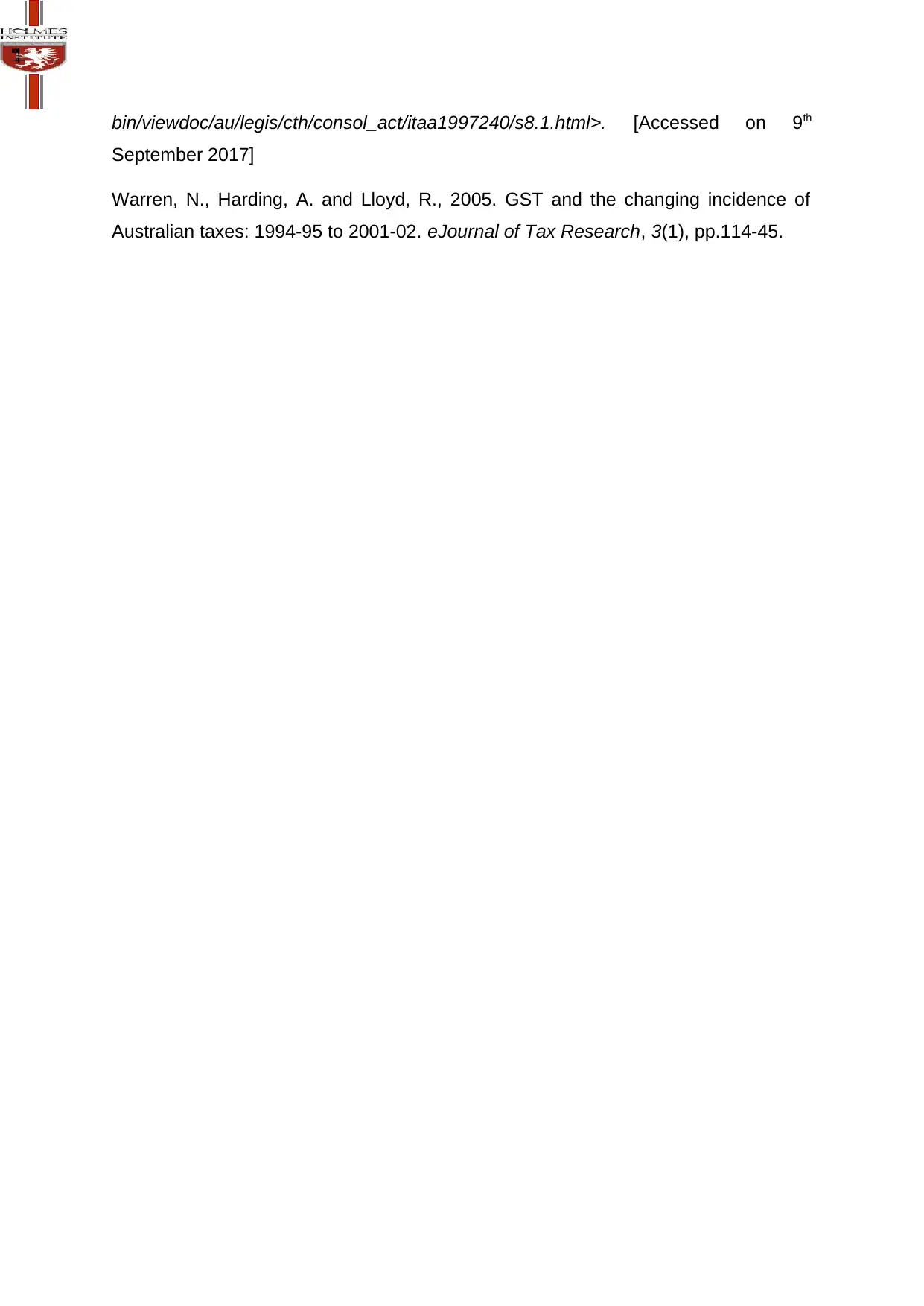
bin/viewdoc/au/legis/cth/consol_act/itaa1997240/s8.1.html>. [Accessed on 9th
September 2017]
Warren, N., Harding, A. and Lloyd, R., 2005. GST and the changing incidence of
Australian taxes: 1994-95 to 2001-02. eJournal of Tax Research, 3(1), pp.114-45.
September 2017]
Warren, N., Harding, A. and Lloyd, R., 2005. GST and the changing incidence of
Australian taxes: 1994-95 to 2001-02. eJournal of Tax Research, 3(1), pp.114-45.
1 out of 11
Related Documents
Your All-in-One AI-Powered Toolkit for Academic Success.
+13062052269
info@desklib.com
Available 24*7 on WhatsApp / Email
![[object Object]](/_next/static/media/star-bottom.7253800d.svg)
Unlock your academic potential
Copyright © 2020–2025 A2Z Services. All Rights Reserved. Developed and managed by ZUCOL.




